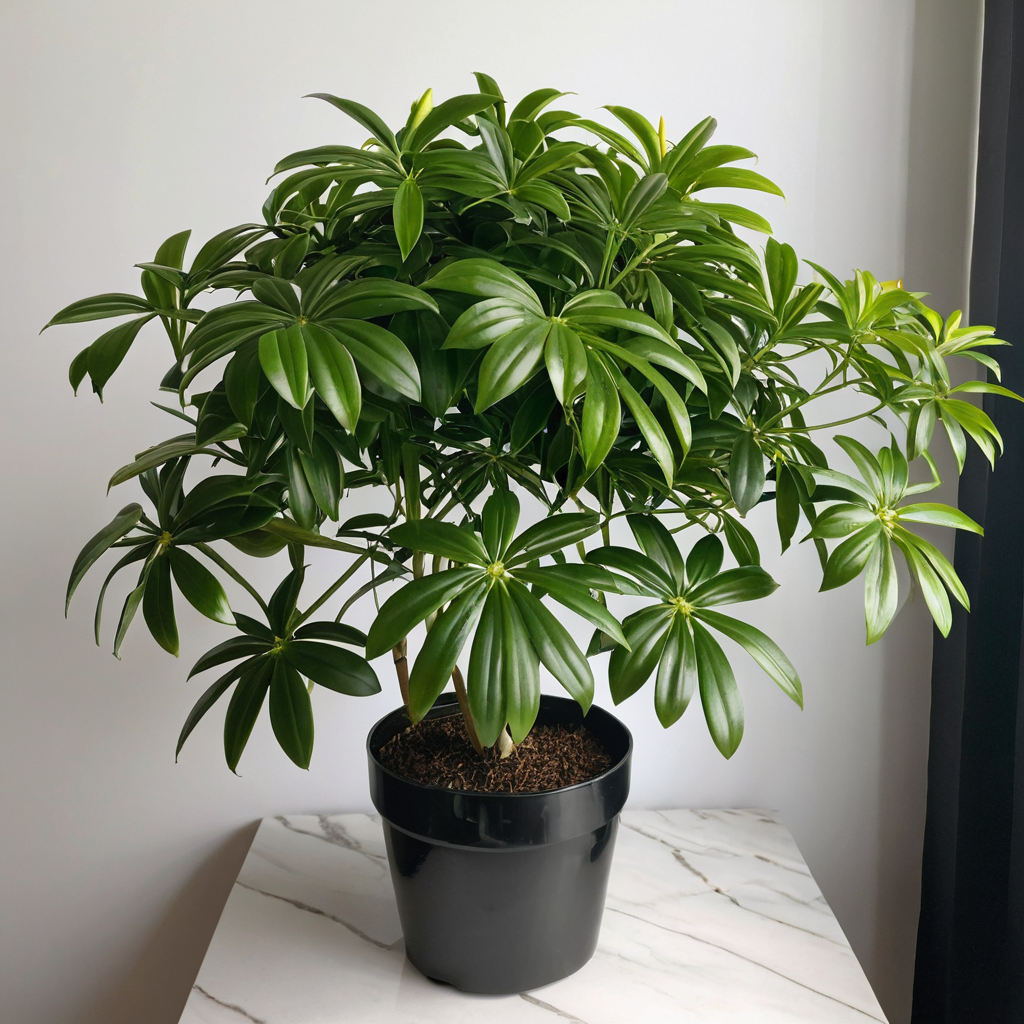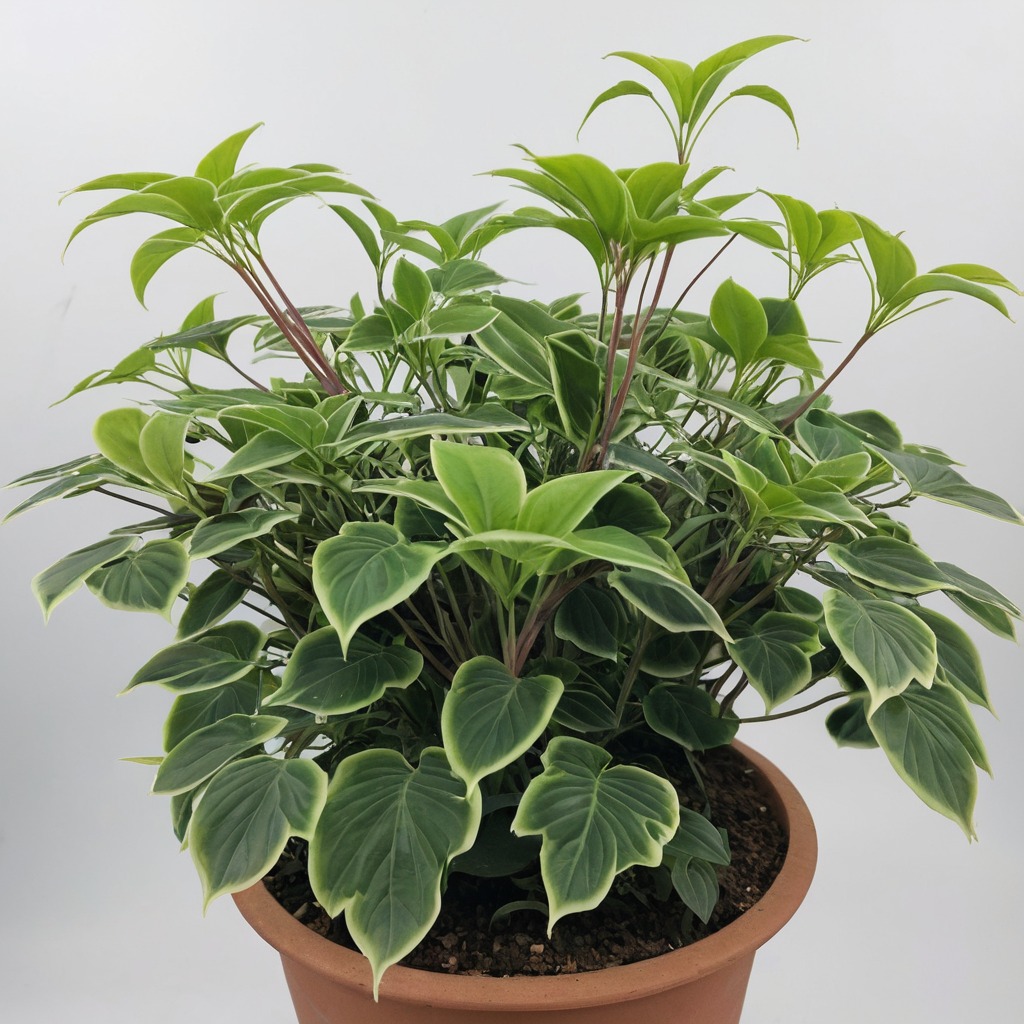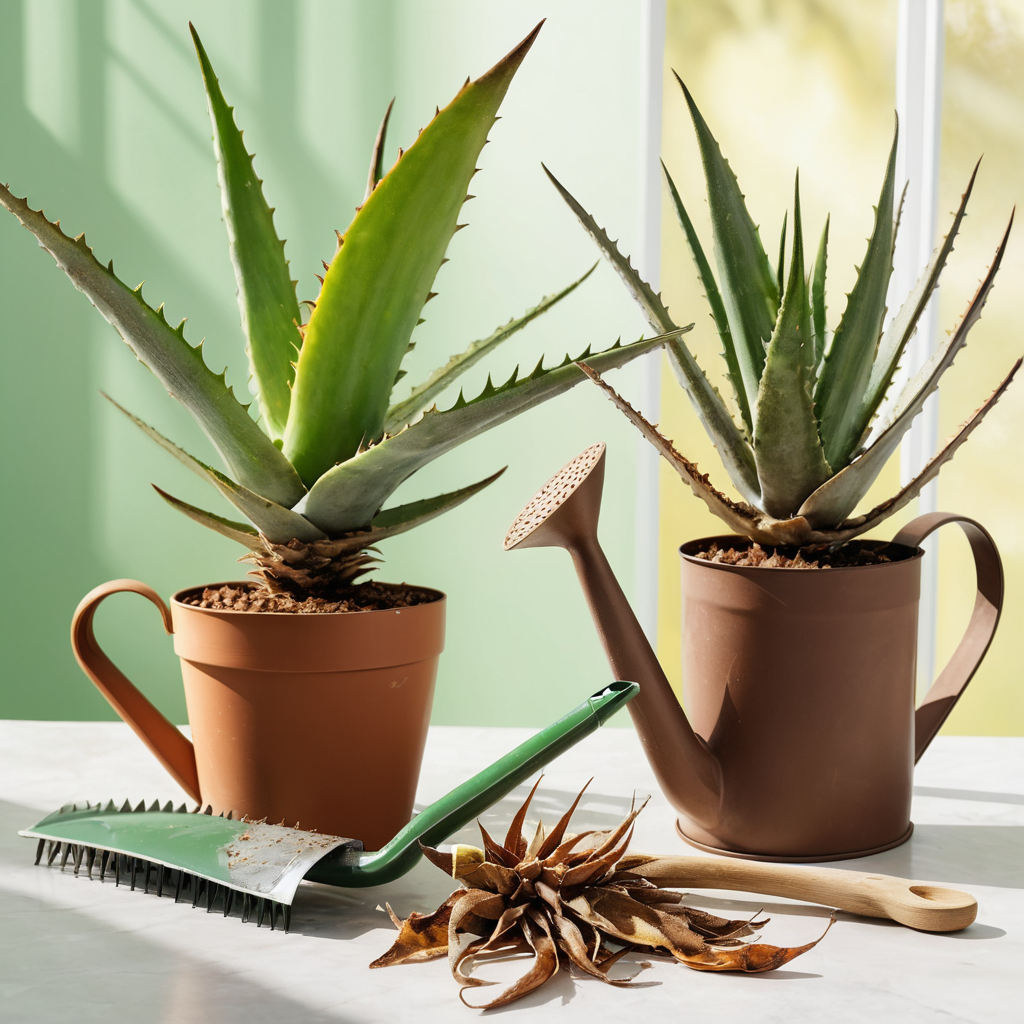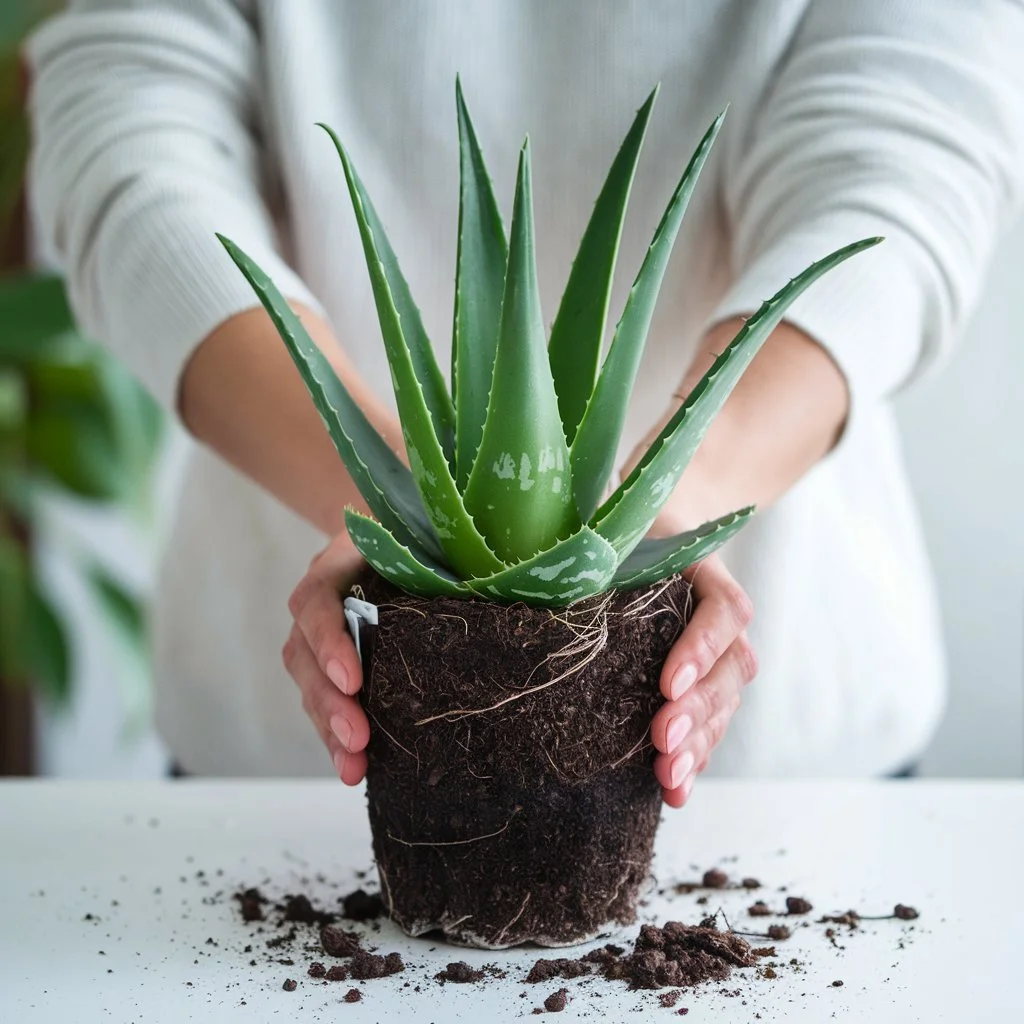The holiday season isn’t complete without a gorgeous, glowing Christmas tree standing proudly in your living room. But there’s one holiday drama no one wants to deal with—a droopy, dry Tannenbaum dropping needles faster than Santa can say “Ho, ho, ho!” If you’ve ever wondered why your tree stops drinking water or how to keep it looking fresh until the New Year, you’re not alone.
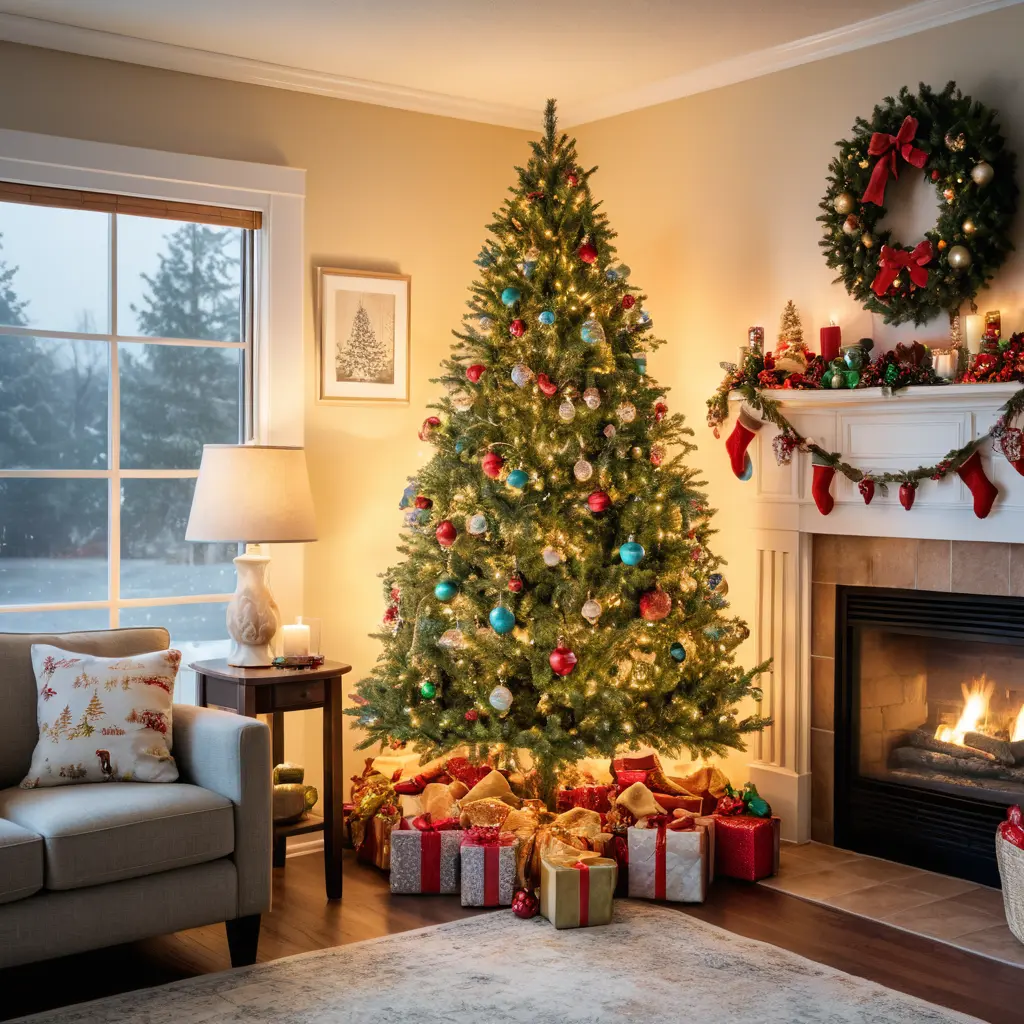
The good news? We’ve got all the tips and tricks you need to keep your tree hydrated, healthy, and the center of attention at every holiday gathering. From understanding why your tree might turn into a picky drinker to simple hacks for keeping it lush and green, we’re covering it all. So grab a mug of hot cocoa, settle in, and get ready to save your tree—and your holiday spirit. Let’s dive in!
To keep your Christmas tree fresh and hydrated, make a fresh cut at the base before placing it in water and ensure the tree stand is always filled with clean water. Place the tree away from heat sources like radiators and fireplaces to prevent drying. Regularly check and refill the water, as trees can drink up to a gallon daily in the first week.
Understanding Why Your Christmas Tree Might Stop Drinking Water
Nothing takes the sparkle out of the holidays faster than a dry, drooping Christmas tree. You’ve picked the perfect Tannenbaum, decked it out in dazzling lights and ornaments, and now it’s… not drinking water? If your tree suddenly refuses to stay hydrated, don’t fret. The issue might be simpler than you think. By understanding why your tree has become a picky drinker, you can take the right steps to keep it fresh and festive all season long. Let’s dive into what’s going on with your tree and how to fix it.
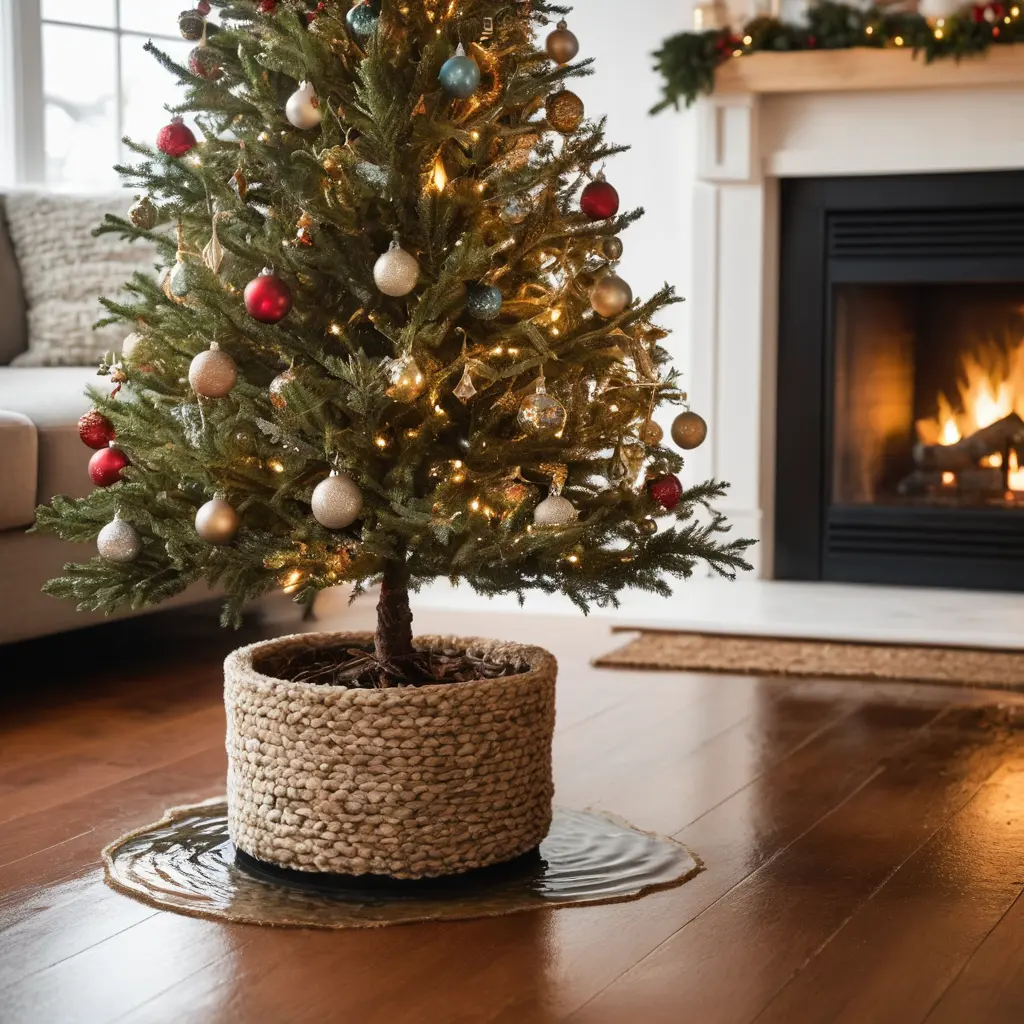
The Science Behind Tree Hydration
Christmas trees are far from ordinary houseplants—they’re festive evergreens with a unique way of staying hydrated after being cut. Once harvested, your tree continues to function in some surprising ways.
- Fresh Cuts and Vascular Pathways: When you cut down a Christmas tree, its vascular system—tiny tubes in the trunk that carry water—remains active for a while. This system allows the tree to absorb water from the stand, keeping its needles plump and branches supple.
- Water Is the Key to Needle Retention: A well-hydrated tree holds onto its needles longer, preventing them from becoming brittle and falling off. Water also helps maintain that lush green color, which is crucial for keeping the Christmas spirit alive!
- The Sap Sealing Effect: Here’s the tricky part: if the base of the tree isn’t properly cared for, sap can dry and harden at the cut. This creates a natural barrier that blocks the tree’s ability to drink water—like trying to sip from a straw with the end glued shut.
The science boils down to this: your tree needs consistent hydration to stay fresh, and anything that interrupts that process can lead to trouble.
Common Reasons for Dehydration: Diagnosing the Issue
If your tree seems to have stopped drinking, don’t worry—it’s usually not too late to intervene. Here are some common reasons your tree might be drying out and what you can do about them:
1. The Base Wasn’t Freshly Cut
When a tree is harvested or left out too long before being set up, the exposed trunk starts to seal itself with sap. This natural defense mechanism locks the tree’s ability to absorb water, even if you have a full stand ready.
- Why It Happens: Sap begins to harden as soon as the tree is cut. Without a fresh cut before placing it in water, the hardened sap prevents hydration.
- How to Fix It: Before setting up your tree, use a saw to make a fresh cut about 1–2 inches above the original end of the trunk. This exposes fresh wood, allowing water to flow freely again.
2. Crooked or Blocked Trunk Base
A wobbly or uneven cut can create issues with water absorption. Additionally, debris like sawdust or bark fragments can clog the trunk’s base.
- Why It Happens: An uneven base may not sit flat in the stand, limiting water access. Debris can also block the tree’s drinking pathways.
- How to Fix It: Ensure the trunk is cut cleanly and evenly before placing it in the stand. Double-check that the base is free of dirt or obstructions.
3. Environmental Dryness
Your tree’s surroundings play a big role in how well it stays hydrated. If it’s positioned near a heat source or in a room with low humidity, dehydration speeds up dramatically.
- Why It Happens: Warm air from fireplaces, radiators, or sunny windows accelerates water loss. Similarly, homes with low humidity can pull moisture from the tree’s needles and bark.
- How to Fix It:
-
- Keep your tree away from heat sources and direct sunlight.
- Use a humidifier to add moisture to the air, especially if your home tends to be dry during winter.
4. Low Water Levels in the Stand
This is one of the most common causes of dehydration, and thankfully, one of the easiest to address!
- Why It Happens: Trees drink a surprising amount of water, especially in the first week after being set up. If the water level in the stand drops below the base of the trunk, the exposed wood can seal over with sap, cutting off its ability to drink.
- How to Fix It: Check the water level in the stand at least twice a day during the first week and top it off as needed. Make sure the base of the trunk is always submerged.
5. Tree Age or Quality
Sometimes, the issue isn’t your care—it’s the tree itself. If you’ve unknowingly chosen a tree that was cut weeks ago, it might already be too dry to drink effectively.
- Why It Happens: Pre-cut trees at some lots may have been harvested long before the holiday season, making them less likely to stay hydrated.
- How to Fix It: When selecting a tree, gently bend the needles. If they snap instead of flex, the tree may already be too dry. Opt for a fresher tree or visit a local farm to cut your own.
By diagnosing the issue and taking action, you’ll not only save your Christmas tree but also keep your holiday décor looking picture-perfect all season long!
Watering Your Christmas Tree: Best Practices
A hydrated Christmas tree is a happy tree, but how do you keep it sipping away like it’s at a spa all season long? The key is regular, thoughtful watering! It’s not just about filling the stand once and calling it a day—your tree has needs, and if you want it to stay fresh, it’s time to become the ultimate tree hydration expert. Here’s how to make sure your tree stays well-watered, healthy, and the star of your holiday celebrations.
How Often Should You Water a Christmas Tree?
If you’ve ever left your tree alone for a few days and come back to a sad, drooping mess, you know just how thirsty those evergreens can get. The general rule is simple: water, water, and more water!
- The First Week Is Crucial: In the first 7 days, a freshly cut tree can drink up to a gallon of water a day, so it’s essential to check the water level at least twice a day during this period.
- After the First Week: After the initial thirst-quenching frenzy, your tree will drink less, but you should still check the water every couple of days. If the stand ever runs dry, the tree’s base can seal over, and hydration becomes tricky again.
- Tree Size Matters: Larger trees tend to drink more water, so make sure your stand can accommodate the water needs of your specific tree size.
Pro Tip: If you’re away or hosting guests and can’t monitor it every day, set a reminder to top off the stand. Keeping the water levels consistently high ensures your tree stays hydrated and happy.
The Right Way to Water Your Christmas Tree
It’s not just about pouring water into the stand and hoping for the best. There’s a right way to water your tree that will make all the difference between a fresh, vibrant centerpiece and a sad, shedding decoration.
- Use Room Temperature Water: Cold water can shock the tree’s roots, while hot water may cause the needles to wilt prematurely. Stick to room temperature water for the best results.
- Fill the Stand Slowly: Pour water into the stand slowly so that the trunk can properly absorb it, avoiding spillage. Try to keep the water level above the tree’s base but below the lower branches.
- Avoid Additives: Some people like to add things like sugar, aspirin, or bleach to the water, thinking it’ll keep the tree fresher longer. But guess what? Your tree just needs plain, good old water to stay hydrated and happy. Keep it simple!
- Check for Leaks: It’s easy to forget, but make sure the stand itself isn’t leaking water. Even a small leak can quickly lower the water levels, and your tree will be left high and dry.
Quick Tip: If you’re worried about your tree’s water absorption, remember to keep the stand’s water level topped off consistently. A thirsty tree won’t thrive if the water is too low!
Watering your Christmas tree is like giving it a holiday spa day—regular attention, the right methods, and a little TLC go a long way. Stick to these practices, and you’ll have a tree that stays fresh and festive all through the season.
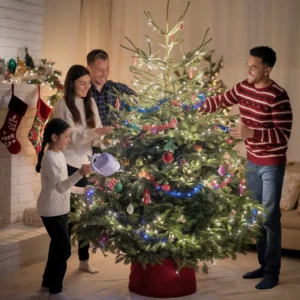
Tips for Keeping Your Christmas Tree Hydrated and Healthy
A healthy, hydrated Christmas tree isn’t just about watering—it’s also about setting it up right and giving it the proper care throughout the holiday season. Here are some expert tips to ensure your tree stays lush and vibrant, from the moment you bring it home from the Christmas tree lot to the final days of the season.
Preparing the Tree: Proper Cutting and Setup
Before you can hang that beautiful Christmas tree garland or add the final touches, make sure your tree is set up for success.
- Make a Fresh Cut: Once you bring your tree home, give it a fresh cut (about 1-2 inches off the base). This ensures that the Christmas tree can drink water more easily by re-opening the tree’s vascular system.
- Place the Tree in Water Right Away: As soon as you’ve made the fresh cut, place your tree in a stand with water. The sooner you get it in, the better it will stay hydrated.
- Check the Stand’s Size: Make sure your tree stand is the right size for the height and width of your tree. A stand that’s too small can prevent the tree from absorbing enough water.
Pro Tip: If you’re wondering, “Are there any Christmas tree lots near me that offer pre-cut trees with fresh cuts?”—check the tree’s freshness by bending the needles. If they snap or fall off easily, it might be too late for the tree to stay hydrated effectively.
Optimal Placement in Your Home (Avoiding Heat Sources)
Where you place your Christmas tree in your home can make all the difference in how long it stays hydrated and healthy.
- Avoid Direct Heat Sources: Keep your tree away from fireplaces, heaters, and sunny windows. Heat dries out the tree faster, causing it to lose moisture more quickly.
- Cool and Humid Rooms Are Best: Place your tree in a cooler, more humid room, if possible. Rooms with air conditioning or a Christmas palm tree in a corner can be a great way to maintain a consistent temperature for your tree.
- Keep It Away From Doors: Avoid placing your tree near doors that open and close frequently, as drafts can dry out the tree and cause stress.
Fun Fact: If you’re looking for a quirky twist, consider a cactus Christmas tree! These unique trees have a low water requirement and can thrive in drier environments, making them a perfect choice for homes with dry air.
Enhancing Water Retention with Smart Practices
Once your Christmas tree is set up, the next step is ensuring it keeps absorbing water as efficiently as possible.
- Use a Tree Preservative: Some tree preservatives can help improve water absorption and reduce needle drop. Just make sure they are safe and designed for Christmas trees.
- Add Moisture Around the Tree: If your home is particularly dry, consider placing a humidifier near your tree. This can help the tree retain moisture and prevent the needles from dropping too quickly.
- Cover the Tree Stand: A tree skirt or cloth around the base of the tree stand can help keep the water temperature stable and prevent it from evaporating too quickly.
Quick Tip: Always check the water levels in your stand twice a day, especially during the first few days after setup. A Christmas tree that’s drinking regularly will last much longer!
Long-Term Maintenance: Ensuring Freshness Until New Year’s
To keep your Christmas tree healthy and vibrant all season long, you need to stay on top of its care—especially as the holiday festivities heat up.
- Maintain Consistent Watering: Continue to check the water levels and refill the stand regularly. Don’t let the water drop below the base of the trunk, or your tree will stop absorbing it altogether.
- Keep an Eye on Needle Drop: If your tree starts shedding needles early, it could be a sign of dehydration or too much heat. Adjust the temperature and humidity in your home to keep your tree as fresh as possible.
- End of Season Care: As the season comes to a close, make sure to remove any Christmas tree garland and ornaments carefully. You can also recycle your tree at a local farm or recycling center to give it a second life after the holidays.
By following these easy tips, you can keep your Christmas tree looking beautiful from the day you bring it home to the moment you ring in the New Year! Whether you’re celebrating with a traditional pine or a cactus Christmas tree, proper care ensures your tree will continue spreading holiday cheer.
Bonus: Quick Fixes for Dehydrated Trees
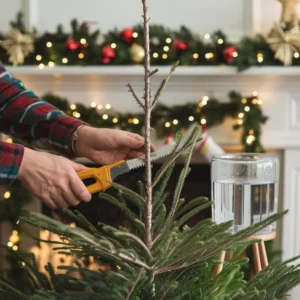 Uh-oh! If your Christmas tree has started drooping, shedding needles, or seems to be parched despite your best efforts, don’t worry—we’ve got some quick fixes to help bring your tree back to life. Whether it’s the result of dehydration or just a little too much holiday hustle and bustle, these fixes will help revive your tree and keep it looking fresh. Let’s dive in!
Uh-oh! If your Christmas tree has started drooping, shedding needles, or seems to be parched despite your best efforts, don’t worry—we’ve got some quick fixes to help bring your tree back to life. Whether it’s the result of dehydration or just a little too much holiday hustle and bustle, these fixes will help revive your tree and keep it looking fresh. Let’s dive in!
How to Revive a Dry Christmas Tree
If your Christmas tree is looking a bit worse for wear, the first step is to check its water levels. But if it’s too late for that, don’t panic—here are a few tricks to help rehydrate your tree and save the day.
- Make a Fresh Cut: If your tree hasn’t been drinking for a while, the sap may have sealed off the trunk’s vascular system. Take 1–2 inches off the base of the tree, exposing fresh wood so it can start absorbing water again.
- Give It a Soak: If you’ve got a smaller Christmas tree, consider removing it from the stand and soaking the bottom of the trunk in a bucket of water for a few hours. This can help the tree absorb water quickly.
- Warm Water Works Wonders: If your tree is really thirsty, try filling the stand with lukewarm water. While room temperature is ideal, warm water can encourage quicker absorption if your tree’s especially dry.
- Hydrate with a Humidifier: If your home is dry, place a humidifier near your Christmas tree to increase moisture levels in the air. This helps the tree retain hydration, and it’s especially useful for those with dry winters or air conditioning.
Pro Tip: Keep a close eye on your tree’s water levels for the next few days and top it off frequently—this is crucial to get it back to its festive, hydrated self.
When It’s Time to Say Goodbye
Unfortunately, sometimes no matter how hard you try, a Christmas tree just can’t be saved. If you’ve tried all the tricks and your tree is still drooping or dropping needles like a snowstorm, it might be time to let go. Here are some signs it’s time to say goodbye:
- Excessive Needle Drop: If your tree is losing needles faster than you can clean them up, it’s likely a sign that the tree is beyond saving.
- Brittle, Brown Needles: If the needles feel dry and snap off with just a touch, your tree is too far gone to stay hydrated and healthy.
- The Water Level Isn’t Changing: If the water in your stand hasn’t been going down and the tree isn’t drinking, it could mean that it’s sealed off completely and no longer absorbing moisture.
Final Tip: Even if your tree is at the end of its lifespan, consider recycling it! Check with local farms or Christmas tree lots near me to see if they offer tree recycling services for composting or mulching.
Whether you’re rescuing a dehydrated Christmas tree or accepting that it’s time for a new one, these quick fixes will help you keep your holiday season merry and bright—no matter what!
FAQ
How can I encourage my Christmas tree to absorb water?
To encourage your Christmas tree to absorb water, make sure the trunk is freshly cut before placing it in the stand. Keep the stand filled with water at all times, especially in the first few days, and ensure the tree is not exposed to heat sources, which can cause rapid dehydration.
What causes a Christmas tree to stop taking in water?
A Christmas tree may stop drinking water if the cut end of the trunk becomes sealed with sap, blocking the water channels. Additionally, if the tree stand runs dry, the base can seal over, preventing further absorption. Poor placement near heat sources or inadequate watering can also hinder hydration.
What’s the best way to bring a dry Christmas tree back to life?
To revive a dry Christmas tree, make a fresh cut at the base of the trunk to reopen the water channels. Then, place the tree in a stand filled with fresh, room-temperature water and keep it in a cool, humid environment. Regularly check and refill the water level to ensure proper hydration.
Why does my Christmas tree feel so dry?
Your Christmas tree may feel dry due to dehydration, which can happen if it hasn’t been watered enough or if the base was not properly prepared with a fresh cut. Excessive heat or low humidity can also contribute to the tree’s dryness.
How can I hydrate a tree that’s become too dry?
To hydrate a dry tree, trim 1-2 inches off the bottom of the trunk to expose fresh wood, and place it immediately into water. Allow the tree to soak up water for several hours or overnight, then ensure it remains consistently watered to avoid further dehydration.
How long can a Christmas tree survive without water?
A Christmas tree can survive for about 4-7 days without water, though it will begin to dry out quickly after that. If the water level drops below the base of the trunk, the tree’s ability to absorb water is severely compromised.
Is it possible to revive a dehydrated Christmas tree?
Yes, it’s possible to revive a dehydrated Christmas tree by making a fresh cut at the base and ensuring it is properly hydrated in a stand filled with water. However, if the tree has been dry for too long, it may not recover fully.
Will misting my Christmas tree with water help it stay fresh?
Misting your Christmas tree with water can provide temporary moisture to the needles but will not significantly impact the tree’s overall hydration. Consistent water in the stand is essential for keeping the tree healthy.
What happens if I forget to trim the bottom of my Christmas tree?
If you forget to trim the bottom of the tree’s trunk, the sap may seal the cut, preventing the tree from absorbing water properly. This can lead to dehydration and a dry tree, causing premature needle drop.
Is it possible to overwater a Christmas tree?
Overwatering a Christmas tree is generally not a concern, as long as the water is contained within the stand. However, if the stand is constantly overflowing, it could lead to water damage to your floor, but the tree itself will typically drink as much water as it needs.
Conclusion
In conclusion, keeping your Christmas tree hydrated and healthy throughout the holiday season doesn’t have to be a daunting task. With the right care—fresh cuts, regular watering, and mindful placement—you can ensure your tree stays lush and vibrant, bringing joy and holiday cheer to your home. By following these simple steps, you’ll be able to enjoy a beautifully fresh Christmas tree all season long. So, go ahead, deck those branches with your favorite Christmas tree garland and ornaments, and let your tree shine bright all through the holidays! Happy decorating!
Check out our latest article for more insights, and follow us on Facebook for updates! and connect with us on Instagram, Pinterest, and YouTube for more inspiration!

